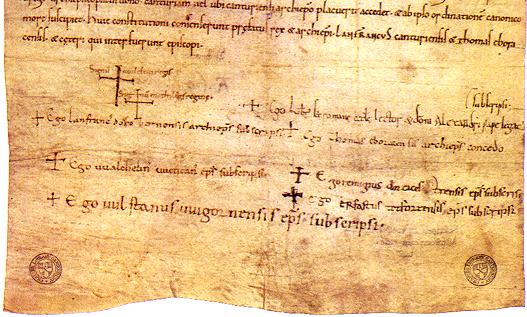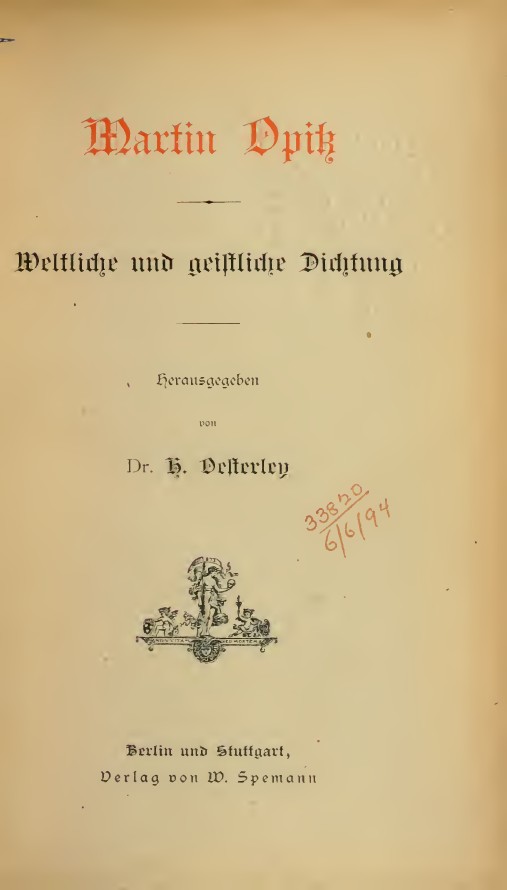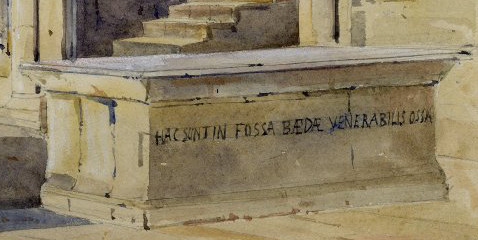|
Williram Of Ebersberg
Williram of Ebersberg (died 3 January 1085) was a Benedictine Abbot. He is best known for his 'Expositio in Cantica Canticorum', a complex commentary of the Song of Songs which includes an Old High German translation and a Latin verse paraphrase. Biography Williram came from a noble family in the Rhine area, related, among others, to the archbishop Heribert of Cologne (999–1021), the Würzburg bishop Heinrich (995–1018), and the Eichstätt bishops Heribert (1022–1042) und Gezemann (1042). Ca.1020, he entered the Benedictine monastery Fulda, then in the 1040s became teacher in the Benedictine monastery Michelsberg in Bamberg, together among others with bishop Suidger, the future pope Clemens II. (1046–1047). Williram belonged to the court circle of emperor Henry III (1039–1056). In 1048, he became abbot at the Benedictine monastery of Ebersberg where he remained until his death 1085. He was a friend of the Benedictine abbot Wilhelm of Hirsau for whom he wrote a new v ... [...More Info...] [...Related Items...] OR: [Wikipedia] [Google] [Baidu] |
Lanfranc
Lanfranc, OSB (1005 1010 – 24 May 1089) was a celebrated Italian jurist who renounced his career to become a Benedictine monk at Bec in Normandy. He served successively as prior of Bec Abbey and abbot of St Stephen in Normandy and then as Archbishop of Canterbury in England, following its Conquest by William the Conqueror. He is also variously known as ( it, Lanfranco di Pavia), (french: Lanfranc du Bec), and ( la, Lanfrancus Cantuariensis). Early life Lanfranc was born in the early years of the 11th century at Pavia, where later tradition held that his father, Hanbald, held a rank broadly equivalent to magistrate. He was orphaned at an early age. Lanfranc was trained in the liberal arts, at that time a field in which northern Italy was famous (there is little or no evidence to support the myth that his education included much in the way of Civil Law, and none that links him with Irnerius of Bologna as a pioneer in the renaissance of its study). For unknown reasons ... [...More Info...] [...Related Items...] OR: [Wikipedia] [Google] [Baidu] |
Annolied
The ''Annolied'' (''"Song of Anno"'') is an Early Middle High German poem in praise of Archbishop Anno II of Cologne. Anno died in 1075 and the poem, probably written in the years immediately after his death, can be seen as part of a campaign for his canonisation, which was finally achieved in 1183. Sources There is no surviving manuscript of the ''Annolied''. Our knowledge of the poem comes mainly from the printed version published by Martin Opitz in 1639. Part of the poem had been published previously by Bonaventura Vulcanius in 1597, but this was only a short extract from the start of the work (strophes 2,1–5,4)). There are significant differences between the two printed versions: Vulcanius's is missing the prologue, has some additional lines, and differing strophe divisions. The two editors, therefore, must have drawn on different manuscripts, conventionally called *V and *O after their later editors. However, the two manuscripts seem to be closely related and the codex pr ... [...More Info...] [...Related Items...] OR: [Wikipedia] [Google] [Baidu] |
Martin Opitz
Martin Opitz von Boberfeld (23 December 1597 – 20 August 1639) was a German poet, regarded as the greatest of that nation during his lifetime. Biography Opitz was born in Bunzlau (Bolesławiec) in Lower Silesia, in the Principality of Schweidnitz-Jauer, the son of a prosperous citizen. He received his early education at the gymnasium of his native town, of which his uncle was rector, and in 1617 attended the high school—"Schönaichianum"—at Beuthen an der Oder (Bytom Odrzański), where he made a special study of French, Dutch and Italian poetry. In 1618 he entered the University of Frankfurt-on-Oder as a student of ''literae humaniores'', and in the same year published his first essay, '' Aristarchus, sive De contemptu linguae Teutonicae'', which presented the German language as suitable for poetry. In 1619 Opitz went to Heidelberg, where he became the leader of the school of young poets which at that time made that university town remarkable. Visiting Leiden in ... [...More Info...] [...Related Items...] OR: [Wikipedia] [Google] [Baidu] |
Paulus Merula
Paulus Merula, or Paul van Merle (Dordrecht, 19 August 1558 - Rostock, 20 July 1607) was a Dutch jurist, classicist, historian, geographer and librarian. In 1592 he was appointed professor of history at Leiden University, and was elevated to full professor in 1593. From 1597 until his death he was librarian to Leiden University Library, and in 1603 he was appointed rector magnificus of the university. He was friends with Janus Dousa and Daniël Heinsius, and was a Leiden contemporary of the humanist Joseph Justus Scaliger.Paulus Merula on the Biografisch portaal van NederlandPaulus Merula on the website ''Leidse hoogleraren'' His most important work was a two-part history of |
Leiden University Library
Leiden University Libraries is a library founded in 1575 in Leiden, Netherlands. It is regarded as a significant place in the development of Culture of Europe, European culture: it is a part of a small number of cultural centres that gave direction to the development and spread of knowledge during the The Age of Enlightenment, Enlightenment. This was due particularly to the simultaneous presence of a unique collection of exceptional sources and scholars. Holdings include approximately 5,200,000 volumes, 1,000,000 e-books, 70,000 electronic journal, e-journals, 2,000 current paper Academic journal, journals, 60,000 Oriental and Western manuscripts, 500,000 Letter (message), letters, 100,000 maps, 100,000 Printmaking, prints, 12,000 drawings and 300,000 photographs. The library manages the largest collections worldwide on Indonesia and the Caribbean. Furthermore, Leiden University Libraries is the only heritage organization in The Netherlands with three registrations of documents in ... [...More Info...] [...Related Items...] OR: [Wikipedia] [Google] [Baidu] |
Old Dutch
In linguistics, Old Dutch (Dutch: Oudnederlands) or Old Low Franconian (Dutch: Oudnederfrankisch) is the set of Franconian dialects (i.e. dialects that evolved from Frankish) spoken in the Low Countries during the Early Middle Ages, from around the 5th to the 12th century. Page 27: "''...Aan het einde van de negende eeuw kan er zeker van Nederlands gesproken worden; hoe long daarvoor dat ook het geval was, kan niet met zekerheid worden uitgemaakt.''" t can be said with certainty that Dutch was being spoken at the end of the 9th century; how long that might have been the case before that cannot be determined with certainty./ref> Old Dutch is mostly recorded on fragmentary relics, and words have been reconstructed from Middle Dutch and Old Dutch loanwords in French. Old Dutch is regarded as the primary stage in the development of a separate Dutch language. It was spoken by the descendants of the Salian Franks who occupied what is now the southern Netherlands, northern Belgium, p ... [...More Info...] [...Related Items...] OR: [Wikipedia] [Google] [Baidu] |
Cartulary
A cartulary or chartulary (; Latin: ''cartularium'' or ''chartularium''), also called ''pancarta'' or ''codex diplomaticus'', is a medieval manuscript volume or roll (''rotulus'') containing transcriptions of original documents relating to the foundation, privileges, and legal rights of ecclesiastical establishments, municipal corporations, industrial associations, institutions of learning, or families. The term is sometimes also applied to collections of original documents bound in one volume or attached to one another so as to form a roll, as well as to custodians of such collections. Definitions Michael Clanchy defines a cartulary as "a collection of title deeds copied into a register for greater security". A cartulary may take the form of a book or a ''codex''. Documents, chronicles or other kinds of handwritten texts were compiled, transcribed or copied into the cartulary. In the introduction to the book ''Les Cartulaires'', it is argued that in the contemporary diplomatic ... [...More Info...] [...Related Items...] OR: [Wikipedia] [Google] [Baidu] |
Exposition (literary Technique)
Narrative exposition is the insertion of background information within a story or narrative. This information can be about the setting, characters' backstories, prior plot events, historical context, etc. In literature, exposition appears in the form of expository writing embedded within the narrative. Exposition is one of four rhetorical modes (also known as ''modes of discourse''), along with description, persuasion, and narration, as elucidated by Alexander Bain and John Genung. In essays An expository paragraph presents facts, gives directions, defines terms, and so on. It should clearly inform readers about a specific subject. An expository essay is one whose chief aim is to present information or to explain something. To ''expound'' is to set forth in detail, so a reader will learn some facts about a given subject. However, no essay is merely a set of facts. Behind all the details lies an attitude, a ''point of view''. In exposition, as in other rhetorical modes, deta ... [...More Info...] [...Related Items...] OR: [Wikipedia] [Google] [Baidu] |
Vulgate
The Vulgate (; also called (Bible in common tongue), ) is a late-4th-century Latin translation of the Bible. The Vulgate is largely the work of Jerome who, in 382, had been commissioned by Pope Damasus I to revise the Gospels used by the Roman Church. Later, on his own initiative, Jerome extended this work of revision and translation to include most of the books of the Bible. The Vulgate became progressively adopted as the Bible text within the Western Church. Over succeeding centuries, it eventually eclipsed the . By the 13th century it had taken over from the former version the designation (the "version commonly used") or for short. The Vulgate also contains some ''Vetus Latina'' translations which Jerome did not work on. The Vulgate was to become the Catholic Church's officially promulgated Latin version of the Bible as the Sixtine Vulgate (1590), then as the Clementine Vulgate (1592), and then as the ''Nova Vulgata'' (1979). The Vulgate is still curr ... [...More Info...] [...Related Items...] OR: [Wikipedia] [Google] [Baidu] |
Hexameter
Hexameter is a metrical line of verses consisting of six feet (a "foot" here is the pulse, or major accent, of words in an English line of poetry; in Greek and Latin a "foot" is not an accent, but describes various combinations of syllables). It was the standard epic metre in classical Greek and Latin literature, such as in the ''Iliad'', ''Odyssey'' and ''Aeneid''. Its use in other genres of composition include Horace's satires, Ovid's ''Metamorphoses,'' and the Hymns of Orpheus. According to Greek mythology, hexameter was invented by Phemonoe, daughter of Apollo and the first Pythia of Delphi.Pliny the Elder, 7.57 __TOC__ Classical Hexameter In classical hexameter, the six feet follow these rules: * A foot can be made up of two long syllables (– –), a spondee; or a long and two short syllables, a dactyl (– υ υ). * The first four feet can contain either one of them. * The fifth is almost always a dactyl, and last must be a spondee. A short syllable (υ) is a syllabl ... [...More Info...] [...Related Items...] OR: [Wikipedia] [Google] [Baidu] |
Leonine Verse
Leonine verse is a type of versification based on internal rhyme, and commonly used in Latin verse of the European Middle Ages. The invention of such conscious rhymes, foreign to Classical Latin poetry, is traditionally attributed to a probably apocryphal monk Leonius, who is supposed to be the author of a history of the Old Testament (''Historia Sacra'') preserved in the Bibliothèque Nationale of Paris. This "history" is composed in Latin verses which rhyme in the center. It is possible that this Leonius is the same person as Leoninus, a Benedictine musician of the twelfth century, in which case he would not have been the original inventor of the form. It is sometimes referred to disparagingly as "jangling verse" by classical purists, for example 19th century antiquaries, who consider it absurd and coarse and a corruption of and offensive to the high ideals of classical literature. In English, the rhyme may be between a word within the line (often before a caesura) and the wor ... [...More Info...] [...Related Items...] OR: [Wikipedia] [Google] [Baidu] |





.jpg)
